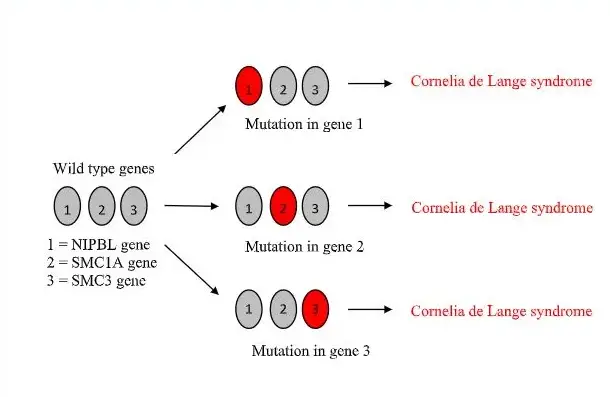Genetic diversity underpins much of our understanding of biology and medicine, serving as a cornerstone for unraveling the complex mechanisms that dictate hereditary traits and susceptibilities to diseases. Each human genome is a mosaic of inherited sequences that contribute uniquely to an individual’s phenotype. Among these variations, allelic and locus heterogeneity represent critical concepts in genetics, influencing everything from genetic disorder manifestation to treatment responses.
Allelic heterogeneity occurs when different mutations at the same genetic locus cause a similar phenotype. Conversely, locus heterogeneity refers to mutations at different loci producing the same phenotype. These phenomena highlight the complexity of genetic diseases and the challenges faced in genetic diagnosis and treatment, influencing how researchers and clinicians approach genetic disorders and their inheritance patterns.
These concepts are fundamental in medical genetics, particularly in the context of diagnosing and managing genetic disorders. By examining the implications of allelic and locus heterogeneity, scientists and medical professionals can better predict disease risk, understand varied patient responses to treatments, and develop more effective genetic testing methods.

Core Concepts
Genetic Variation
What is Genetic Variation?
Genetic variation is the diversity in DNA sequences between individuals within a species. This variation can come from mutations, gene duplications, and other genetic rearrangements. It is the raw material for evolution and plays a critical role in an organism’s ability to adapt to changing environments.
Types of Genetic Variation
Genetic variation manifests in several ways:
- Single nucleotide polymorphisms (SNPs): These are the most common type of genetic variation, where a single nucleotide (A, T, C, or G) in the genome differs from one individual to another.
- Insertions and deletions (indels): These occur when DNA segments are inserted or deleted from a genome.
- Copy number variations (CNVs): Differences in the number of copies of a particular gene or region of a chromosome among individuals.
- Structural variations: Large-scale alterations in the genome structure, such as inversions and translocations.
Gene Expression
Basics of Gene Expression
Gene expression is the process by which the instructions in our DNA are converted into a functional product, such as a protein. This process involves two main steps:
- Transcription: The DNA sequence of a gene is copied to make messenger RNA (mRNA).
- Translation: The mRNA is used as a template to synthesize proteins.
These proteins can then perform a vast array of functions within the cell, from speeding up chemical reactions as enzymes to providing structural support in the cytoskeleton.
How Genes Control Traits
Genes influence traits by dictating the production of proteins that have specific roles in the body. The expression levels of genes can affect:
- Physical traits such as height, eye color, and hair color.
- Behavioral traits such as learning and memory abilities.
- Susceptibility to diseases and response to medications.
Allelic Heterogeneity
Definition
Allelic heterogeneity occurs when different mutations at the same genetic locus affect the same trait or disease in similar ways.
What is Allelic Heterogeneity?
This phenomenon is observed when multiple, distinct mutations in a single gene produce the same or similar disease phenotypes.
Key Characteristics
- Multiple mutations, same gene: Various mutations can occur within the same gene, each potentially leading to similar outcomes.
- Disease manifestations: These mutations may alter the function of the protein produced by the gene, leading to disease.
Examples
Common Diseases
Conditions such as cystic fibrosis and sickle cell anemia demonstrate allelic heterogeneity. Different mutations in the CFTR gene can cause cystic fibrosis, similarly, various mutations in the HBB gene are responsible for sickle cell anemia.
Impact on Genetic Disorders
Allelic heterogeneity complicates genetic testing and diagnosis because multiple tests may be necessary to identify the specific mutation present in a gene. It also affects treatment strategies and requires a personalized approach to healthcare.
Locus Heterogeneity
Definition
Locus heterogeneity refers to the presence of mutations at different genetic loci that can result in the same phenotype or disease.
What is Locus Heterogeneity?
This type of heterogeneity occurs when similar symptoms or conditions are caused by variations in different genes, which may be involved in the same biochemical pathway or physiological process.
Key Characteristics
- Different genes, similar outcomes: Mutations in different genes lead to similar disease manifestations.
- Complex diagnosis: Identifying the exact cause of a disease can be challenging due to the potential involvement of multiple genes.
Examples
Specific Case Studies
For example, retinitis pigmentosa, a genetic disorder of the eyes that causes loss of vision, can be caused by mutations in any one of more than 50 genes. Each gene plays a role in the development or function of photoreceptor cells or the retina.
Effects on Diagnosis
The presence of locus heterogeneity necessitates comprehensive genetic screening to correctly diagnose and treat conditions effectively. This can involve multiple genetic tests and detailed family histories to understand the genetic underpinnings of a disease accurately.
Comparative Analysis
Similarities
Overlapping Aspects
Both allelic and locus heterogeneity share the underlying concept that genetic diversity affects phenotypic outcomes, emphasizing the complexity of genetic traits and diseases. In both types, mutations that influence the same trait or disease can come from different origins, highlighting the intricate nature of genetic coding and expression.
Genetic Implications
The occurrence of both types of heterogeneity illustrates a significant challenge in the prediction of genetic diseases based on genotype alone. This similarity necessitates more comprehensive approaches in genetic analysis and interpretation, stressing the importance of broad genetic testing and family history evaluation.
Differences
Distinct Features
While allelic heterogeneity involves multiple mutations within the same gene, locus heterogeneity deals with mutations in different genes causing similar diseases. This distinction is crucial for understanding the genetic architecture of complex diseases and influences the strategies used in genetic counseling and testing.
Influence on Genetic Testing
- Allelic Heterogeneity: Requires in-depth analysis of a single gene to identify all potential mutations that could contribute to a disease phenotype.
- Locus Heterogeneity: Demands a broader scope, often requiring whole-genome or multi-gene panels to identify the genetic cause of similar phenotypic outcomes.
Impacts and Implications
Medical Diagnosis
Challenges in Diagnosing Genetic Conditions
The presence of genetic heterogeneity significantly complicates the diagnostic process. Clinicians must consider multiple potential genetic causes when a patient presents with symptoms that could be attributed to various genetic anomalies. This complexity can lead to:
- Increased time and cost of diagnosis
- The need for more specialized genetic testing
- Potential for misdiagnosis or delayed diagnosis
Role in Personalized Medicine
Understanding both types of heterogeneity is pivotal in the development of personalized medicine. It allows healthcare providers to tailor treatments based on the specific genetic profile of an individual, enhancing the efficacy and reducing the side effects of treatments.
Research and Development
Influence on Genetic Research
Genetic heterogeneity pushes the boundaries of current genetic research, challenging scientists to develop more sophisticated tools for genetic analysis. This includes:
- Advanced sequencing technologies
- Improved bioinformatic tools for data analysis
- Enhanced models for understanding genetic interactions within pathways
Advancements in Genetic Engineering
The challenges posed by genetic heterogeneity also fuel innovations in genetic engineering, such as CRISPR and other gene-editing technologies. These tools offer potential ways to correct multiple mutations across different genes, paving the way for novel therapeutic approaches.
Future Perspectives
Emerging Technologies
Rapid advancements in genomic technologies and artificial intelligence are expected to revolutionize our approach to understanding and manipulating genetic materials. Technologies like next-generation sequencing (NGS) and machine learning models that predict genetic interactions are becoming more refined, providing deeper insights into complex genetic patterns.
Potential Breakthroughs in Genetics
The future of genetics holds promising breakthroughs that may fundamentally change the diagnosis, treatment, and prevention of genetic disorders. Potential developments include:
- Gene therapy: More targeted and efficient methods to replace or repair defective genes.
- Pharmacogenomics: The development of drug therapies that are specifically tailored to an individual’s genetic makeup.
- Predictive genetics: Enhanced predictive models that use genetic information to forecast disease risk and outcome, potentially shifting the focus from treatment to prevention in healthcare.
Frequently Asked Questions
What is allelic heterogeneity?
Allelic heterogeneity refers to the presence of different mutations within the same gene, all of which alter the gene’s function and contribute to similar disease phenotypes. This diversity in genetic mutations complicates diagnosis and treatment, as each mutation may affect the gene differently.
How does locus heterogeneity affect genetic testing?
Locus heterogeneity can significantly impact genetic testing by requiring broader tests to identify the genetic cause of a disease. Since multiple genes may be involved, comprehensive testing ensures that all potential genetic contributions are considered, improving diagnostic accuracy.
Why is understanding genetic heterogeneity important?
Understanding genetic heterogeneity is crucial for developing effective treatment strategies. It helps in tailoring treatments that are specific to the genetic makeup of an individual, paving the way for personalized medicine. Additionally, it aids researchers in understanding the full scope of genetic contributions to diseases.
Can genetic heterogeneity influence disease severity?
Yes, genetic heterogeneity can influence the severity and progression of diseases. Different mutations may lead to varying degrees of disease severity, even among individuals diagnosed with the same genetic condition, affecting prognosis and treatment options.
Conclusion
Allelic and locus heterogeneity are pivotal in shaping our approach to understanding and managing genetic disorders. These genetic complexities necessitate sophisticated diagnostic tools and tailored therapeutic strategies, highlighting the need for advanced genetic research. As we continue to uncover the nuances of these genetic variations, the potential for more personalized and effective medical interventions becomes increasingly feasible.
The study of genetic heterogeneity not only enriches our knowledge of genetic diseases but also enhances our capacity to confront them effectively. Future advancements in genetic technologies and methodologies are expected to further refine our approach to these complex genetic puzzles, offering hope for more precise and personalized healthcare solutions.

